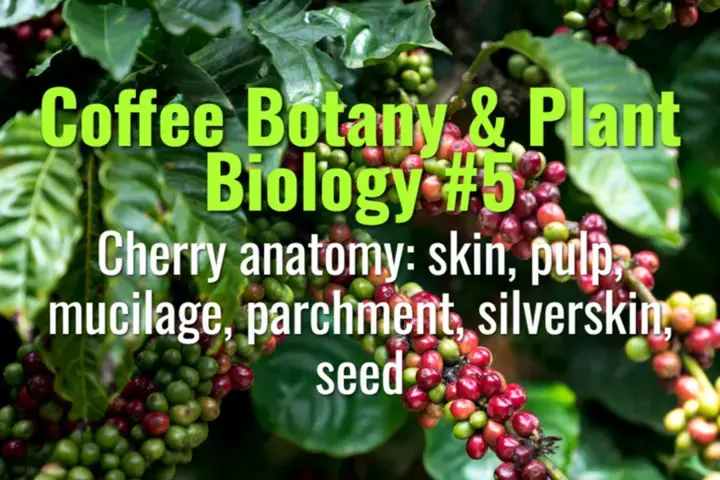Cherry anatomy: skin, pulp, mucilage, parchment, silverskin, seed
This topic breaks down the structure of the coffee cherry, layer by layer, showing how each part influences processing, flavor development, and the quality of the final cup.
- Coffee Basics Nerds
- 2 min read
Article 5 of 12 in Coffee Botany & Plant Biology/

Overview
A coffee cherry is a drupe (stone fruit) composed of multiple layers that protect and nurture the seeds (the coffee beans). Each layer has agricultural and processing significance.
Layers of the Coffee Cherry
1. Skin (Exocarp)
- Description: Smooth, outer layer; green when unripe, turning red, yellow, or orange when mature (depending on variety).
- Function: Protects the fruit from pests, UV light, and dehydration.
- Processing: Removed during pulping or left intact in natural/dry processing.
2. Pulp (Mesocarp)
- Description: Fleshy, sugary fruit beneath the skin.
- Function: Provides nutrition during seed development.
- Processing impact: High sugar content influences fermentation flavors if not removed quickly.
3. Mucilage
- Description: Gelatinous, sticky layer rich in pectins and sugars.
- Function: Cushions the seed and influences microbial fermentation.
- Processing impact: Controlled fermentation of mucilage directly affects acidity, sweetness, and mouthfeel.
4. Parchment (Endocarp)
- Description: Papery protective shell surrounding the bean.
- Function: Shields seed during maturation and drying.
- Processing: Beans are dried inside parchment (parchment coffee) before hulling.
5. Silverskin (Perisperm)
- Description: Thin, papery layer tightly clinging to the bean.
- Roasting impact: Often burns and flakes off as chaff in roasting.
- Cup quality: Harmless if retained in small amounts but can impart off-flavors if excessive.
6. Seed (Endosperm)
- Description: The actual coffee bean, typically two per cherry, flat on one side and convex on the other.
- Peaberry: A single, round seed when one fails to develop.
- Composition: Rich in carbohydrates, proteins, lipids, caffeine, and chlorogenic acids—these compounds define coffee’s flavor upon roasting.
Significance of Each Layer
- Skin & pulp: Key in natural processing (drying with fruit attached).
- Mucilage: Central to wet and honey processes, shaping sweetness and acidity.
- Parchment: Crucial for safe storage and transport of green coffee.
- Silverskin: Mostly removed during roasting, but relevant to defects.
- Seed: The prized product, its chemistry determines aroma and flavor.
Lasting Importance
Understanding cherry anatomy is essential for:
- Farmers: Harvesting at peak ripeness.
- Processors: Choosing methods that highlight desirable flavor.
- Roasters: Anticipating bean behavior in roasting.
- Consumers: Appreciating how each layer contributes to the cup.